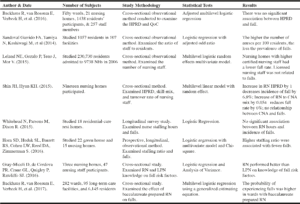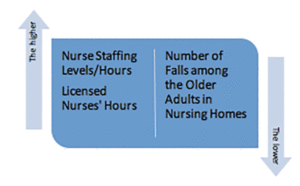O.O. Omotowa1, L.C. Hussey2
1. Idaho State University School of Nursing, Idaho Fall, USA; 2. Walden University School of Nursing, Columbia, Maryland, USA. Corresponding author: Omotayo O. Omotowa, Idaho State University School of Nursing, Idaho Falls ID 83402, USA, omotomot@isu.edu, Telephone: 2082821117, Fax: 2082827966
Jour Nursing Home Res 2020;6:90-92
Published online October 9, 2020, http://dx.doi.org/10.14283/jnhrs.2020.24
Abstract
Adequate nurse staffing levels are critical to nursing homes’ residents’ quality of care outcomes. The number of nurse staffing hours per resident day directly affects being with, and supervising residents’ activities in ways to prevent falls. Studies have shown some negative direct relationships between nurse staffing levels and occurrences of falls in nursing homes. The objective of this report is to examine the relationship between nurse staffing and occurrence of falls in nursing homes. Articles were search from nursing and health care databases such as CINAHL Plus, Academic Search Complete, Medline Complete, and ProQuest Nursing using different levels of nurse staffing, nursing homes, and long-term care. Information was also retrieved from the Center for Diseases Prevention and Control and the Centers for Medicare and Medicaid Services websites. Results showed that increased number of total nurses, increased licensed nurses, and increase ratio of registered nurses to certified nurse aids skill-mix were related to fewer numbers of falls. Falls are detrimental to nursing homes’ older adults’ quality of life. Adequate nurse staffing levels is imperative to maintain the dignity, wellbeing, and quality of life for vulnerable nursing homes’ residents.
Key words: Nursing homes, nurse staffing, falls.
Falls
Falls, an adverse event affecting quality of life and wellbeing experiences among nursing homes’ older adults, are an unfortunate common occurrence happening to a large number of this population every year in the United States. The occurrence of falls is reported to be happening to 50%-75% of the 1.4 million older adult nursing homes’ residents every year in the United States (1). Frailty and reduced physiological functionality predispose this population to increased danger of falling. In some cases, the older adult residents sustain injuries such open wounds, fractures, and traumatic brain injury that lead to functional disability, morbidity, poor quality of life, and/or eventual deaths (1-5).
Older adults residing in nursing homes experience worse outcomes and complication rates after falls and upon admission to the hospital when compared to their community counterparts (5-6). Impact of falls on the residents and their families continue to be a source of concern for all nursing homes health care stakeholders. In general, studies showed that causes of falls among the older adults population were mostly due to the presence of multiple diseases, cognitive impairment, increased mobility and physical activities, poly-pharmacy, urinary incontinence, unsafe gait/balance difficulty, weak body parts, malnutrition, limb impairment, decreased peak muscle power, and inadequate safety equipment (2, 4, 7, 8). In nursing homes, successful prevention of falls measures would involve assessment and identification of risk factors, especially the modifiable factors, and effective focused intervention activities (2, 9) by adequate number of higher skilled nurse staffing.
Some studies have revealed that nursing homes residents experience falls in different locations such as hallways, dining rooms, lounges, and the greater occurrences associated with fractures happen in the residents’ bedrooms and bathrooms (5, 10). Majority of the falls among residents happened during unknown activities (this implies that the staff was unaware of what and how happened when the falls occurred), followed by when walking and transferring; and, infrequently during reaching, sitting, and standing (5, 10). Residents were also found to fall during all hours of the day, with the most incidences happening in the early morning hours from 5 a. m to 8 a. m (5). This time window is when care delivery process is heightened and the need for nursing care and assistance by the older adults from nurses is usually higher.
The Relationship between Nurse Staffing Levels and Falls
Adequate nurse staffing levels are critical to nursing homes’ residents’ quality of care outcomes. Different levels of nurse staffing, skills-mix, and total nurses’ hours were studied as predictors of falls, with or without serious injuries, among the nursing homes’ residents (11-14). Researchers examined the impact of nurse staffing on falls incidences using total nurse (TN) hours per resident day (HPRD) and registered nurse skill-mix (11); registered nurse, registered nurse skill-mix, and certified nurse aide HPRD (14); and certified nurse aide and licensed nurse HPRD (13). These studies showed that insufficient number of nurse staffing HPRD, staffing to resident ratio, and inadequate registered nurse skill-mix affect the process and quality of care provided to the residents, including assessment, being with, caring for, and supervising their cares and activities for fall prevention. An overview of the studies reviewed is shown in Table 1.
Researchers found out that higher number of TN (certified nurse aide and registered nurse) staffing per 100 residents (12), increase registered nurse HPRD, increase staffing to resident ratio, and increase registered nurse to certified nurse aide skills-mix (14, 16) contributed to reduced fall rate. Findings also showed that consistent staffing and higher certified nurse aide, registered nurse, and licensed practical nurse HPRD (13, 16) were related to fewer number of fall incidences in nursing homes and facilities providing long term care services for the older adults. In determining the registered nurses and licensed practical nurses’ knowledge on eight causes of falls, Gray-Miceli, de Cordova, Crane, Quigley, & Ratcliffe (17) found that registered nurses had higher average knowledge scores than the licensed practical nurses, even though neither correctly identified all the causes of falls among the older adults. The authors considered registered nurses’ scores an indication of better performance in falls prevention (17); making increased registered nurse staffing level a positive factor in reduction of falls.
A few of the studies showed mixed outcomes of the relationships of nurse staffing and falls among the older adults in nursing homes or long term care facilities (13-15). A lack of statistically significant relationships were reported between occurrence of falls and nurse staffing levels or skills-mix; and all direct care nurse staffing HPRD including certified nurse aide, nurse aide, licensed vocational nurse, baccalaureate prepared registered nurse, trained feeding assistants, untrained staff, and trainees (11, 14-15). A mixed methods study on newly admitted short-stay nursing homes residents concluded that licensed nurses (registered and licensed practical/vocational nurses) were not significantly associated with falls (13). A study by Backhaus et al. (18) showed an increase in probability of falls among the older adults in somatic facilities (wards that provide care for residents with physical disabilities) that employed baccalaureate prepared registered nurses.
It is evident that inadequate nurse staffing hours and unlicensed nurse skills are detrimental to nursing homes older adults’ safe and quality of care processes and outcomes. Falls are increasingly prevalent among the older adult nursing homes’ residents due to their frailty, aging process, medical conditions, and vulnerability. Adequate and appropriate nurse staffing levels are necessary for avoidance of falls and maintenance of wellbeing, dignity (19), and quality of end of life for the nursing homes older adults.
Conflict of interest: The authors did not get financial support nor had an affiliation with any organization with any financial or non-financial interest in the subject matter discussed in this article.
Ethical Standards: This article does not violate any ethical standards. It does not involve one-on-one interaction with human or animal participants.
References
1. Center for Disease Control and Prevention. Home and recreational Safety: Important facts about falls, 2017. Retrieved from https://www.cdc.gov/homeandrecreationalsafety/falls/adultfalls.html
2. Álvarez Barbosa F, Pozo-Cruz B, Pozo-Cruz J, et al. Factors associated with the risk of falls of nursing home residents aged 80 or older. Rehabilitation Nursing 2016; 41(1): 16.
3. Cantalice Alves AH, Freire de Araújo Patrício AC, Fernan des de Albuquerque K, et al. Occurrence of falls among elderly institutionalized: prevalence, causes and consequences. Revista De Pesquisa: Cuidado E Fundamental 2016; 8(2): 4376-4386.
4. Damián J, Pastor-Barriuso R, Valderrama-Gama E, de Pedro-Cuesta J. Factors associated with falls among older adults living in institutions. BMC Geriatrics 2013; 13(6): 1-9.
5. McArthur C, Gonzalez DA, Roy E, Giangregorio L. What are the circumstances of falls and fractures in long-term care? Canadian Journal on Aging / La Revue canadienne du vieillissement 2016; 35(4): 491-498.
6. Botwinick I, Johnson JH, Safadjou S, et al. Geriatric nursing home falls: A single institution cross-sectional study. Archives of Gerontology and Geriatrics 2016; 63: 43-48.
7. Clancy A, Balteskard B, Perander B, Mahler M. Older persons’ narrations on falls and falling–Stories of courage and endurance. International Journal of Qualitative Studies on Health & Well-Being 2015; 10: 1-10.
8. Lannering C, Ernsth Bravell M, Midlöv P, Östgren C, Mölstad S. Factors related to falls, weight-loss and pressure ulcers – more insight in risk assessment among nursing home residents. Journal of Clinical Nursing 2016; 25(7/8): 940-950.
9. Kadono NA, Pavol MJ. Effects of aging-related losses in strength on the ability to recover from a backward balance loss. Journal of Biomechanics 2013; 46(1): 13–18.
10. Robinovitch S, Feldman F, Yang Y, et al. Video capture of the circumstances of falls in elderly people residing in long-term care: an observational study. Lancet n.d; 381(9860): 47-54.
11. Backhaus R, van Rossum E, Verbeek H, et al. Quantity of staff and quality of care in Dutch nursing homes: A cross-sectional study. Journal of Nursing Home Research 2016; 2: 90-93.
12. Sandoval Garrido FA, Tamiya N, Kashiwagi M, et al. Relationship between structural characteristics and outcome quality indicators at health care facilities for the elderly requiring long-term care in Japan from a nationwide survey. Japan Geriatric Society 2014; 14(2): 301-308.
13. Leland NE, Gozalo P, Teno J, Mor V. Falls in newly admitted nursing home residents: A national study. Journal of the American Geriatrics Society 2012; 60(5): 939-945.
14. Shin JH, Hyun KH. Nurse staffing and quality of care of nursing home residents in Korea. Journal of Nursing Scholarship 2015; 47(6): 555-564.
15. Whitehead N, Parsons M, Dixon R. Quality and staffing: Is there a relationship in residential aged care. Kai Tiaki Nursing Research 2015; 6(1): 28-35. Retrieved from http://www.kaitiakiads.co.nz/research-journal/
16. Horn SD, Hudak SL, Barrett RS, Cohen LW, Reed DA, Zimmerman S. Interpersonal care processes, falls, and hospitalizations in green house and other nursing homes. Seniors Housing & Care Journal 2016; 24(1): 31-46. Retrieved from http://www.nic.org/analytics/publications/seniors-housing-care-journal/
17. Gray-Miceli D, de Cordova PR, Crane GL, Quigley P, Ratcliffe SJ. Nursing home registered nurses’ and licensed practical nurses’ knowledge of causes of falls. Journal of Nursing Care Quality 2016; 31(2): 153-60.
18. Backhaus R, van Rossum E, Verbeek H, et al. Relationship between the presence of baccalaureate-educated RNs and quality of care: a cross-sectional study in Dutch long-term care facilities. BMC Health Services Research 2017; 17(53): 171-179.
19. Centers for Medicare & Medicaid Services. (2015). Nursing home data compendium 2015 edition. Retrieved from https://www.cms.gov


